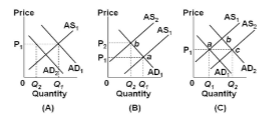Refer to the diagrams, in which AD 1 and AS 1 are the "before" curves and AD 2 and AS 2 are the "after" curves. A recession is depicted by:

A. panel (A) only.
B. panel (B) only.
C. panel (C) only.
D. panels (A) and (B).
D. panels (A) and (B).
You might also like to view...
According to the substitution effect along an indifference curve, when the relative price of a good falls, the consumer ________ substitutes ________ of that good for the other good
A) always; more B) always; less C) sometimes; more D) sometimes; less
Refer to the above figure. At real GDP of $1 trillion, actual investment equals
A) planned investment of $1 trillion. B) planned saving of $1 trillion. C) actual saving of 0. D) unanticipated inventory adjustments of $1 trillion.
Assume a two-country, two-commodity, two-input model. Let the countries in the model be the United States and the Rest of the World and the goods be steel and wheat. The two factors of production are capital and land. Further, the United States is capital-abundant and steel production is capital-intensive. Suppose, in the absence of trade, the United States operates at a point on its production-possibility curve where it produces and consumes twenty units of wheat and twenty units of steel. Once it engages in free trade, the international price of one unit of steel is two units of wheat. In response to the opening of trade, the United States moves along its production-possibility curve to a new point where it produces thirty units of steel and ten units of wheat. Is the United States
better off following the opening of trade? Provide a logical proof of your answer. What will be an ideal response?
The effects of a per-unit tax imposed on sales of an industry's product would likely include
A) a lower product price at any amount of the product supplied. B) a leftward shift of the market supply curve for the product. C) a leftward movement along the market supply curve for the product. D) none of the above.